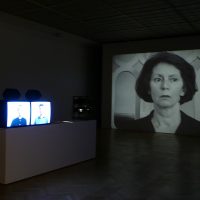The works featured at the exhibition connect along such themes as the fragmentedness of memory, difference and repetition, re-creation of situations and events, or the strategy of re-enactment in relation to history and memory. The exhibited works of Sven Augustijnen, David Claerbout, Ana Torfs and Els Vanden Meersch lay emphasis on the issues of individual and historical memory and oblivion, as well as the exploration of processes of perception, changing points of view, and time as an entity that fundamentally influences memory.
The exhibition’s title is referring to Ana Torfs’ Vérité exposée (Truth Exposed, 2006) a series of 24 prints. Every print shows a distorted projection of a square-shaped light, each time from a different angle, with the word ‘Vérité’ (Truth), written by hand in the middle. Anatomy (2006) is based on extensive research into a trial held in 1919 in Berlin: the ‘Case of the Murder of Dr. Karl Liebknecht and Rosa Luxemburg’, a document that has never been fully published. Torfs pinpointed selected statements from this trial to compose ‘A Tragedy in Two Acts,’ the literary script for her installation with the ambiguous title Anatomy. The installation consists of large black and white slide projections and images on two television monitors.
In Sections of a Happy Moment David Claerbout records a single moment from a multitude of viewpoints, setting the truth of the multiplied image against single-perspective perception. His other work at the exhibition, Bordeaux Piece (2004), is a series of 69 twelve minute filmsequences, each of which displays the same movie scene about love and betrayal. In this work, he examines what happens to a film scene if it is shot 69 times a day. How do the lights, the ambient sounds, the actors’ performance, the emotions change? Are these really the same scene?
Els VandenMeersch considers her photographs, sculptures and installations to be psychological portraits, in which thememory of architecture plays a key role: for her, architecture is memory’s practice ground. Not so much as a memory of something formed into an image, than as the stimulation of the faculty of remembering in general. She presents Prora – a complex originally built as a Nazi holiday camp and then used as Soviet army barracks until the early nineties – as a colossal monument of postpolitical oblivion.
Sven Augustijnen draws a delicate portrait of a patient with aphasia, suffering from chronic memory loss in his moving and unforgettable documentary films Johan (2001) and François (2003). The editing accentuates the unfocused and stammering line of thought of the aphasia patient.


